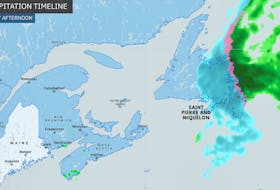I love to learn.

I was blessed with some amazing teachers along the way. One day in biology class I put my hand up to ask a question and said: “This might be a stupid question but…” Mrs. Barlow immediately interrupted by saying, “Cindy, there are no stupid questions, only stupid answers.”
From that day forward, I never hesitated to ask questions. Today, I love to get weather questions from people.
Earlier this month, Gerry Greene emailed this one: Can you explain why there is a “calm before a storm?”
We’ve all experienced it, whether it was at the beach, at a ball game or while barbecuing on the back deck: that familiar afternoon breeze fades, the air becomes still, and the birds stop singing. After a few minutes, you feel a change in the air and, suddenly, threatening clouds appear on the horizon. You quickly dash in the house and narrowly miss those fat, gloopy raindrops that fall just before the sky opens up.
What’s behind this calm before the storm?
Let’s start with a look at how storms form.
Storms need warm, moist air as fuel. As storms develop, they can draw in that air from all directions, even from the air ahead of the storm. As the warm, moist air is pulled into a storm, it leaves an area of low pressure or vacuum close to the ground. With the help of strong updrafts, the air travels into the heart of the storm to fuel it! By the time the warm air reaches the top of the cloud mass, it has cooled off and is now heavier than the air around it. That heavier air then descends and is drawn back down toward the ground by that vacuum it created in the first place.
Now, this little bit of information is key: descending air becomes warmer and drier. Warm, dry air is relatively stable and, once it blankets a region, it stabilizes the air and creates a “calm before a storm”. Not all storms follow a period of calm weather, but I hope this explanation helps you understand those that do.
This day in weather history
There was still 4 cm of snow on the ground in New Glasgow, N.S., and a staggering 33 cm of snow on the ground in Truro April 26, 2015!
The most rain ever in Charlottetown, P.E.I. on April 26 is 21.1 mm - that record has been holding since 1951!
Temperatures are expected to be about eight degrees above normal across Newfoundland and Labrador today. While that’s lovely, it has been much warmer: April 26, 1986, the temperature soared to a record 24.1 C in St. John’s!
- Want more weather information? Visit WeatherByDay.ca
- Have a weather question, photo or drawing to share with Cindy Day? Email [email protected]
Cindy Day is the chief meteorologist for SaltWire Network.









